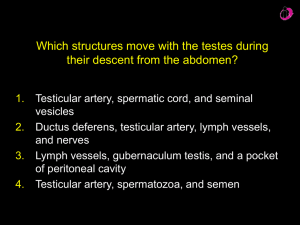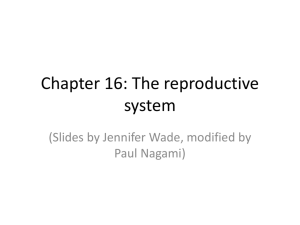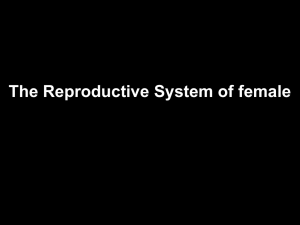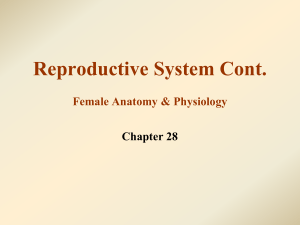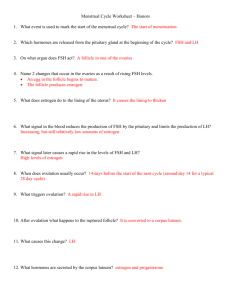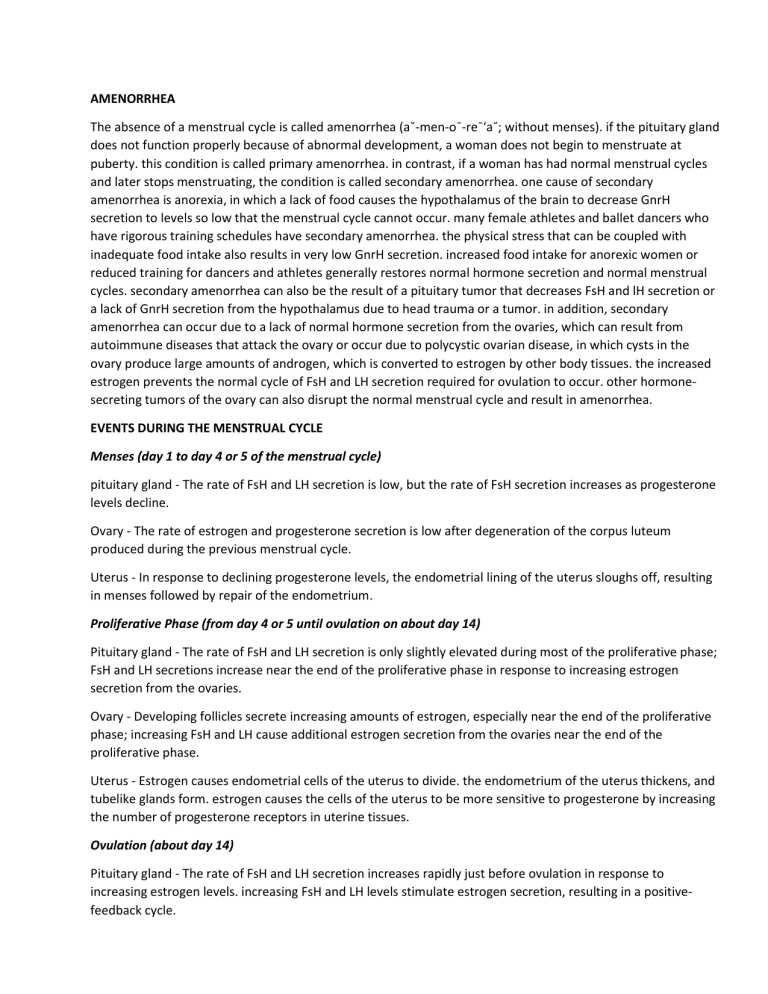
AMENORRHEA The absence of a menstrual cycle is called amenorrhea (a˘-men-o¯-re¯′a˘; without menses). if the pituitary gland does not function properly because of abnormal development, a woman does not begin to menstruate at puberty. this condition is called primary amenorrhea. in contrast, if a woman has had normal menstrual cycles and later stops menstruating, the condition is called secondary amenorrhea. one cause of secondary amenorrhea is anorexia, in which a lack of food causes the hypothalamus of the brain to decrease GnrH secretion to levels so low that the menstrual cycle cannot occur. many female athletes and ballet dancers who have rigorous training schedules have secondary amenorrhea. the physical stress that can be coupled with inadequate food intake also results in very low GnrH secretion. increased food intake for anorexic women or reduced training for dancers and athletes generally restores normal hormone secretion and normal menstrual cycles. secondary amenorrhea can also be the result of a pituitary tumor that decreases FsH and lH secretion or a lack of GnrH secretion from the hypothalamus due to head trauma or a tumor. in addition, secondary amenorrhea can occur due to a lack of normal hormone secretion from the ovaries, which can result from autoimmune diseases that attack the ovary or occur due to polycystic ovarian disease, in which cysts in the ovary produce large amounts of androgen, which is converted to estrogen by other body tissues. the increased estrogen prevents the normal cycle of FsH and LH secretion required for ovulation to occur. other hormonesecreting tumors of the ovary can also disrupt the normal menstrual cycle and result in amenorrhea. EVENTS DURING THE MENSTRUAL CYCLE Menses (day 1 to day 4 or 5 of the menstrual cycle) pituitary gland - The rate of FsH and LH secretion is low, but the rate of FsH secretion increases as progesterone levels decline. Ovary - The rate of estrogen and progesterone secretion is low after degeneration of the corpus luteum produced during the previous menstrual cycle. Uterus - In response to declining progesterone levels, the endometrial lining of the uterus sloughs off, resulting in menses followed by repair of the endometrium. Proliferative Phase (from day 4 or 5 until ovulation on about day 14) Pituitary gland - The rate of FsH and LH secretion is only slightly elevated during most of the proliferative phase; FsH and LH secretions increase near the end of the proliferative phase in response to increasing estrogen secretion from the ovaries. Ovary - Developing follicles secrete increasing amounts of estrogen, especially near the end of the proliferative phase; increasing FsH and LH cause additional estrogen secretion from the ovaries near the end of the proliferative phase. Uterus - Estrogen causes endometrial cells of the uterus to divide. the endometrium of the uterus thickens, and tubelike glands form. estrogen causes the cells of the uterus to be more sensitive to progesterone by increasing the number of progesterone receptors in uterine tissues. Ovulation (about day 14) Pituitary gland - The rate of FsH and LH secretion increases rapidly just before ovulation in response to increasing estrogen levels. increasing FsH and LH levels stimulate estrogen secretion, resulting in a positivefeedback cycle. Ovary - LH causes final maturation of a mature follicle and initiates the process of ovulation. FsH acts on immature follicles and causes several of them to begin to enlarge. Uterus - The endometrium continues to divide in response to estrogen. Secretory Phase (from about day 14 to day 28) Pituitary gland - Estrogen and progesterone reach levels high enough to inhibit FsH and LH secretion from the pituitary gland. Ovary - After ovulation, the follicle is converted to the corpus luteum; the corpus luteum secretes large amounts of progesterone and smaller amounts of estrogen from shortly after ovulation until about day 24 or 25. if fertilization does not occur, the corpus luteum degenerates after about day 25, and the rate of progesterone secretion rapidly declines to low levels. Uterus - In response to progesterone, the endometrial cells enlarge, the endometrial layer thickens, and the glands of the endometrium reach their greatest degree of development; the endometrial cells secrete a small amount of fluid. after progesterone levels decline, the endometrium begins to degenerate. Menses (day 1 to day 4 or 5 of the next menstrual cycle) Pituitary gland - The rate of LH remains low, and the rate of FsH secretion increases as progesterone levels decline. Ovary - The rate of estrogen and progesterone secretion is low. Uterus - In response to declining progesterone levels, the endometrial lining of the uterus sloughs off, resulting in menses followed by repair of the endometrium. Older women experience gradual changes in response to the reduced amount of estrogen and progesterone produced by the ovaries (table 19.4). For example, during the climacteric, some women experience sudden episodes of uncomfortable sweating (hot flashes), fatigue, anxiety, temporary decrease in libido, and occasionally emotional disturbances. Many of these symptoms can be treated successfully with hormone replacement therapy (HRT), which usually consists of small amounts of estrogen and progesterone. HRT has been linked to a slightly increased risk of developing breast cancer, uterine cancer, heart attack, stroke, or blood clots. On the positive side, HRT slows the decrease in bone density that can become severe in some women after menopause, and it decreases the risk of developing colorectal cancer. FEMALE SEXUAL BEHAVIOR AND THE FEMALE SEX ACT Sexual drive in females, like sexual drive in males, is dependent on hormones. Testosterone-like hormones, and possibly estrogen, affect brain cells (especially in the area of the hypothalamus) and influence sexual behavior. Testosterone-like hormones are produced primarily in the adrenal cortex. Psychological factors also play a role in sexual behavior. The sensory and motor neural pathways involved in controlling female sexual responses are similar to those found in the male. During sexual excitement, erectile tissue within the clitoris and around the vaginal opening becomes engorged with blood. The mucous glands within the vestibule, especially the greater vestibular glands, secrete small amounts of mucus. Larger amounts of mucus-like fluid are also extruded into the vagina through its wall. These secretions provide lubrication to allow easy entry and movement of the penis in the vagina during intercourse. Tactile stimulation of the female’s genitals during sexual intercourse and psychological stimuli normally trigger an orgasm, or climax. The vaginal and uterine smooth muscle, as well as the surrounding skeletal muscles, contract rhythmically, and muscle tension increases throughout much of the body. After the sex act, there is a period of resolution, which is characterized by an overall sense of satisfaction and relaxation. Females are sometimes receptive to further immediate stimulation, however, and can experience successive orgasms. Orgasm is not necessary for fertilization to occur. Ovulation results from hormonal stimuli and is not dependent on the female sex act. Endometriosis Helen Hurtz is in her mid-twenties and has been married for 4 years. She has become very frustrated because she experiences pain during and after sexual intercourse, and the pain has become worse over the past 2 years. She also has an increasing, persistent pain in her pelvic region that is especially uncomfortable before and during menstruation and becomes more intense during urination and bowel movements. In addition, she recently developed periodic bouts of diarrhea. She reported all these symptoms to her physician. Helen’s physician suspects endometriosis (en′do¯-me¯-tre¯-o¯′sis), a condition in which endometrial tissue migrates from the lining of the uterus into the peritoneal cavity, where it attaches to the surface of organs. Common sites of attachment are the ovaries and the pelvic peritoneum. Other possible sites are the intestines, uterus, urinary bladder, and vagina. If the attached endometrial tissue has an adequate blood supply, it proliferates, breaks down, and bleeds in response to the hormones produced during the menstrual cycle. Unlike the normal endometrium, which is shed each month during menstruation, endometrial tissue attached outside of the uterus causes lesions or tumors to develop, resulting in internal bleeding, scar tissue formation, inflammation, and pain. Other major complications of endometriosis are infertility and ovarian cyst formation. Between 40% and 50% of infertile women have endometriosis. Helen’s physician explained that the most accurate method of confirming the diagnosis is by laparoscopy, a procedure that allows the physician to visually observe the abdominopelvic cavity. After a few weeks of thinking about the procedure, Helen agreed to the laparoscopic examination. During the procedure, the physician observed several lesions characteristic of endometriosis and removed them with a laser instrument that vaporizes them. Helen’s physician explained to her that there is no cure for endometriosis, but the condition can be managed by administering medication and removing the endometrial lesions periodically. Possible Changes in Postmenopausal Women Caused by Decreased Ovarian Hormone Secretion Menstrual cycle - Five to seven years before menopause, the cycle becomes irregular; the number of cycles in which ovulation does not occur and in which corpora lutea do not develop increases. Uterus - Gradual increase in irregular menstruations is followed by no menstruation; the endometrium finally atrophies, and the uterus becomes smaller. Vagina and external genitalia - The epithelial lining becomes thinner; the external genitalia become thinner and less elastic; the labia majora become smaller; the pubic hair decreases; reduced secretion leads to dryness; the vagina is more easily inflamed and infected. Skin - The epidermis becomes thinner. Cardiovascular system - Hypertension and atherosclerosis occur more frequently. Vasomotor instability - Hot flashes and increased sweating are correlated with vasodilation of cutaneous blood vessels; the hot flashes are related to decreased estrogen levels. Libido - Temporary changes, usually a decrease in libido, are associated with the onset of menopause. Fertility - Fertility begins to decline about 10 years before the onset of menopause; by age 50, almost all the oocytes and follicles have degenerated. Pituitary function - Low levels of estrogen and progesterone produced by the ovaries cause the pituitary gland to secrete larger than normal amounts of LH and FSH; increased levels of these hormones have little effect on the postmenopausal ovaries. CONTROL OF PREGNANCY Many methods are used to prevent pregnancy, either by preventing fertilization (contraception) or by preventing implantation of the developing embryo. many of these techniques are quite effective when used perfectly and consistently. But most of these methods also have disadvantages, and the use of some of them is controversial. Behavioral Methods Abstinence, or refraining from sexual intercourse, is 100% effective in preventing pregnancy when it is practiced consistently. it is not an effective method when used only occasionally. Coitus interruptus (ko¯′i-tu˘s int-e˘- ru˘p′tu˘s), or withdrawal, is removal of the penis from the vagina just before ejaculation. this is a very unreliable method of preventing pregnancy because it requires perfect awareness and willingness to withdraw the penis at the correct time. Statistically, about 23 women out of 100 become pregnant while relying on this method. The withdrawal method also ignores the fact that some sperm cells are present in preejaculatory emissions. The calendar method requires abstaining from sexual intercourse near the time of ovulation. a major factor in the success of this method is the ability to predict accurately the time of ovulation. Although the calendar method provides some protection against becoming pregnant, it has a relatively high failure rate because of both the inability to predict the time of ovulation and the failure to abstain from intercourse around that time. about 9 women out of 100 become pregnant while using the calendar method. Continuous breastfeeding, or lactation (lak-ta¯′shu˘n) (also known as lactation amenorrhea, or lam), often stops the menstrual cycle for up to the first 6 months after childbirth, as long as the baby is exclusively breastfed, and the mother does not resume menstruation while lactating. This method is 99% effective. Continuous breastfeeding works because action potentials sent to the hypothalamus in response to infant suckling inhibit GnrH release from the hypothalamus. Reduced GnrH reduces lH, which prevents ovulation. Eventually, the menstrual cycle resumes. Because ovulation normally precedes menstruation, relying on lactation to prevent pregnancy after the first 6 months postdelivery is not effective. Barrier Methods A male condom (kon′dom) is a sheath made of animal membrane, rubber, or plastic (figure 19aa). When placed over the erect penis, a condom is a barrier device because it collects the semen instead of allowing it to be released into the vagina. Condoms also provide some protection against sexually transmitted diseases. Condoms alone are 98% effective when used correctly, 99% effective when used with spermicide. A vaginal condom (or female condom) also acts as a barrier. a woman can place the vaginal condom into the vagina before sexual intercourse. Female condoms are 95% effective. Using spermicide further increases their effectiveness. Methods to prevent sperm cells from reaching the oocyte once they are in the vagina include a diaphragm, spermicidal agents, and a vaginal sponge. the diaphragm and the cervical cap (figure 19ab) are flexible latex domes that are placed over the cervix within the vagina, where they prevent sperm cells from passing from the vagina through the cervical canal of the uterus. the diaphragm is a larger, shallow latex cup, and the cervical cap is a smaller, thimble-shaped latex cup. Diaphragms are 94% effective, whereas cervical cap effectiveness ranges from 71% in a woman who has previously been pregnant to 86% in a woman who has never been pregnant. the most commonly used spermicidal agents are foams or creams that kill sperm cells (figure 19ac). They are inserted into the vagina before sexual intercourse, often in conjunction with diaphragm or condom use. Alone, spermicidal agents are only about 85% effective. Intrauterine (in′tra¯-yu¯′ter-in) devices (IUDs) (figure 19ad) are inserted into the uterus through the cervix. the two types of IUDs now available in the United States are the copper-containing ParaGard and the progestin hormone–coated Mirena. The ParaGard may be left in place for 12 years, whereas the Mirena may be left in place for 5 years. Both types of IUDs thicken cervical mucus, which bars sperm from entering the uterus. Some women stop ovulating when they have an IUD implanted. IUDs also alter the endometrium, which may prevent implantation of an embryo. IUDs are 99.99% effective in preventing pregnancy. Chemical Methods Synthetic estrogen and progesterone in oral contraceptives (birth control pills) (figure 19ae) are among the most effective contraceptives, providing 99.9% effectiveness. The synthetic steroids can have more than one action, but they reduce LH and FsH release from the anterior pituitary. Estrogen and progesterone are present in high enough concentrations to have a negative-feedback effect on the pituitary, which prevents the large increase in LH and FsH secretion that triggers ovulation. Over the years, the dose of estrogen and progesterone in birth control pills has been reduced. The current lower dose of birth control pills has fewer side effects than earlier dosages. However, the risk of heart attack or stroke increases in female users of oral contraceptives who smoke or who have a history of hypertension or coagulation disorders. For most females, the pill is effective and has a minimum frequency of complications, until at least age 35. The mini-pill is an oral contraceptive that contains only synthetic progesterone. It reduces and thickens the mucus of the cervix, which prevents sperm cells from reaching the oocyte. It also prevents blastocysts from implanting in the uterus. Progesterone-like chemicals, such as medroxyprogesterone (med-rok′-se¯-pro¯- jes′ter-o¯n) (Depo-provera), which are injected intramuscularly and slowly released into the circulatory system, can act as effective contraceptives. Injected progesterone-like chemicals can protect against pregnancy for approximately 1 month, depending on the amount injected, and are 99.9% effective. The patch (ortho evra) is an adhesive skin patch containing synthetic estrogen and progesterone. it is worn on the lower abdomen, buttocks, or upper body and is 99.9% effective. The vaginal contraceptive ring (nuva ring) is inserted into the vagina, where it releases synthetic estrogen and progesterone; it is 99.9% effective. A drug called RU486, or mifepristone (mif′pris-to¯n), blocks the action of progesterone, causing the endometrium of the uterus to slough off as it does at the time of menstruation. It can therefore be used to induce menstruation and reduce the possibility of implantation when sexual intercourse has occurred near the time of ovulation. It can also be used to terminate pregnancies. Morning-after pills, similar in composition to birth control pills, are available. Alternatively, doubling the number of birth control pills after sexual intercourse within 3 days and again after 12 more hours is sometimes recommended. These techniques can be used after intercourse, but they are only about 75% effective. The elevated blood levels of estrogen and progesterone may inhibit the increase in LH that causes ovulation, alter the rate at which the fertilized oocyte is transported through the uterine tube to the uterus, or inhibit implantation. Surgical Methods Vasectomy (va-sek′to¯-me¯) is a common method used to render males permanently infertile without affecting the performance of the sex act. Vasectomy is a surgical procedure in which the ductus deferens from each testis is cut and tied off within the scrotal sac (figure 19af). this procedure prevents sperm cells from passing through the ductus deferens and becoming part of the ejaculate. Because such a small volume of ejaculate comes from the testis and epididymis, vasectomy has little effect on the volume of the ejaculated semen. The sequestered sperm cells are reabsorbed in the epididymis. only 1–4 in 1000 surgeries of this type fail. A common method of permanent birth control in females is tubal ligation (lı¯-ga¯′shu˘n), in which the uterine tubes are tied and cut or clamped by means of an incision through the wall of the abdomen (figure 19ag). This procedure closes off the path between the sperm cells and the oocyte. Commonly, a technique called laparoscopy (lap-a˘-ros′ko˘-pe¯) is used, in which an instrument is inserted into the abdomen through a small incision, so that only small openings need to be made to perform the operation. BENIGN UTERINE TUMORS Leiomyomas (lı¯′o¯-mı¯-o¯′ma˘z), also called uterine fibroids, are fibroid tumors of the uterus (figure 19B). They are one of the most common disorders of the uterus, and the most frequent tumor in women, affecting one of every four. However, three-fourths of the women with this condition experience no symptoms. The enlarged masses that originate from smooth muscle tissue compress the uterine lining (endometrium), resulting in ischemia and inflammation. The increased inflammation, which shares some characteristics with menstruation, results in frequent and severe menses, with associated abdominal cramping due to strong uterine contractions. Constant menstruation is a frequent manifestation of these tumors, and it is one of the most common reasons women elect to have the uterus removed, a procedure called a hysterectomy (his-ter-ek′to¯-me¯). INFERTILITY IN FEMALES Causes of infertility in females include malfunctions of the uterine tubes, reduced hormone secretion from the pituitary gland or the ovaries, and interruption of implantation. Uterine tube malfunction can occur when infections result in pelvic inflammatory disease (PID), which causes adhesions to form in one or both of the uterine tubes. Inadequate secretion of LH and FSH can occur for a variety of reasons, including hypothyroidism or a tumor in or trauma to the hypothalamus or anterior pituitary. Decreased secretion of LH and FSH interrupts ovulation. Interruption of implantation can result from uterine tumors or conditions causing abnormal ovarian hormone secretion. For example, premature degeneration of the corpus luteum causes progesterone levels to decline and menses to occur. If the corpus luteum degenerates before the placenta begins to secrete progesterone, the endometrium and the developing embryonic mass will degenerate and be eliminated from the uterus. The conditions that result in secondary amenorrhea also reduce fertility. BENIGN UTERINE TUMORS Symptoms: • None in 75% of cases • Frequent and severe menses • Strong menstrual uterine cramping Treatment: • Hysterectomy Skeletal: The rate of red blood cell synthesis in the red bone marrow increases. Integumentary: if anemia develops, the skin can appear pale because of the reduced hemoglobin in red blood cells. Urinary: The kidney increases erythropoietin secretion in response to the reduced oxygen-carrying capacity of the blood. The erythropoietin increases red blood cell synthesis in red bone marrow. An enlarged uterine tumor can put pressure on the urinary bladder, resulting in frequent and painful urination. Respiratory: Because of anemia, the oxygen-carrying capacity of the blood is reduced. Increased respiration during physical exertion and rapid fatigue are likely to occur if anemia develops. Cardiovascular: A chronic loss of blood, as occurs in prolonged menstruation over many months to years, frequently results in iron-deficiency anemia. manifestations of anemia include pale skin, reduced hematocrit, reduced hemoglobin concentration, smaller than normal red blood cells (microcytic anemia), and increased heart rate. Muscular: if anemia develops and is severe, muscle weakness results because of the reduced ability of the cardiovascular system to deliver adequate oxygen to muscles. EFFECTS OF AGING ON THE REPRODUCTIVE SYSTEM Aging affects the reproductive system in both men and women in several ways. Sexual activity is often maintained in men and women as they age, but the frequency of sexual intercourse usually decreases gradually. In men, benign prostatic enlargement is common after 50 years of age. A major consequence of prostatic enlargement is blockage of the prostatic urethra. Although benign prostatic enlargement is not preventable, treatments are available to reverse its negative effects. The frequency of prostate cancer also increases as men age and is a significant cause of death in men. In addition, the tendency for erectile dysfunction increases as men age. However, less than 15% of men age 60 or under experience abnormal erectile dysfunction. Keeping physically healthy can minimize some factors leading to abnormal erectile dysfunction, and medical treatments are available. In women, the most significant age-related change is menopause. By age 50, the amount of estrogen and progesterone produced by the ovaries has decreased. The uterus decreases in size, and the endometrium decreases in thickness. The times between menses become irregular and longer until menstruation stops. The vaginal wall becomes thinner and less elastic, and there is less lubricant in the vagina, resulting in an increased tendency for vaginal yeast infections. However, wearing cotton underwear and loose clothing reduces this possibility. In the event of infections, very effective medical treatments are available. Approximately 10% of all women will develop breast cancer. The incidence of breast cancer is greatest between 45 and 65 years of age and is greater for women who have a family history of breast cancer. The single most important measure to guard against death from breast cancer is early detection through breast self-exams and yearly mammograms after age 40. The incidences of uterine cancer, ovarian cancer, and cervical cancer all increase between 50 and 65 years of age. Annual medical checkups, including Pap smears for cervical cancer, are important in order to detect cancer at early stages, when it can be easily treated. DISEASES AND DISORDERS: Reproductive System Infectious Diseases Pelvic inflammatory disease (PID) - Bacterial infection of the female pelvic organs; commonly caused by a vaginal or uterine infection with the bacteria gonorrhea or chlamydia; early symptoms include increased vaginal discharge and pelvic pain; antibiotics are effective; if untreated, can lead to sterility or be life-threatening. Sexually Transmitted Diseases: Commonly known as STDs; spread by intimate sexual contact. Nongonococcal urethritis (non-gon′o¯-kok′a˘l u-re¯-thrı¯′tis) - Inflammation of the urethra that is not caused by gonorrhea; can be caused by trauma, insertion of a nonsterile catheter, or sexual contact; usually due to infection with the bacterium Chlamydia trachomatis (kla-mid′e¯-a˘ tra-ko¯′ma˘- tis); may go unnoticed and result in pelvic inflammatory disease or sterility; antibiotics are effective treatment. Trichomoniasis (trik-o¯-mo¯-nı¯′a˘-sis) - Caused by Trichomonas (trik′o¯-mo¯′nas), a protozoan commonly found in the vagina of women and in the urethra of men; results in a greenish-yellow discharge with a foul odor; more common in women than in men. Gonorrhea (gon-o¯-re¯′a˘) - Caused by the bacterium Neisseria gonorrhoeae (nı¯-se¯′re¯-a˘ gon-o¯-re¯′a˘), which attaches to the epithelial cells of the vagina or male urethra and causes pus to form; pain and discharge from the penis occur in men; asymptomatic in women in the early stages; can lead to sterility in men and pelvic inflammatory disease in women. Genital herpes (her′pe¯z) - Caused by herpes simplex 2 virus; characterized by lesions on the genitals that progress into blisterlike areas, making urination, sitting, and walking painful; antiviral drugs can be effective. Genital warts - Caused by a viral infection; very contagious; warts vary from separate, small growths to large, cauliflower-like clusters; lesions are not painful, but sexual intercourse with lesions is; treatments include topical medicines and surgery to remove the lesions. Syphilis (sif′i-lis) - Caused by the bacterium Treponema pallidum (trep-o¯-ne¯′ma˘ pal′i-du˘m); can be spread by sexual contact; multiple disease stages occur; children born to infected mothers may be developmentally delayed; antibiotics are effective. Acquired immunodeficiency syndrome (AIDS) - Caused by the human immunodeficiency virus (HIV), which ultimately destroys the immune system (see chapter 14); transmitted through intimate sexual contact or by allowing infected body fluids into the interior of another person. In this chapter, we learned that meiosis is cell division that produces haploid cells. When comparing meiosis in males and females, we find that the processes differ in several ways: the stage in an individual’s life when meiosis begins, the types of cells produced, the number of functional cells produced with each cell division, and the stage of life when meiosis ceases to occur. In males, meiosis begins at puberty in the seminiferous tubules. Spermatogonia give rise to primary spermatocytes, which will undergo the process of meiosis. During this process, each primary spermatocyte eventually gives rise to four equal sized mature sperm cells. Meiosis in females is more complex. The process actually begins before a female is even born. During fetal development, many of the oogonia in the ovaries degenerate. The remaining oogonia actually begin meiosis I and are called primary oocytes. At birth, the existing primary oocytes stop meiosis. After puberty and just before the ovulation of each oocyte, the primary oocyte that will be ovulated completes the first meiotic division to produce two different-sized cells: one large secondary oocyte and one small polar body. The secondary oocyte begins the second meiotic division but will complete the process only if fertilized by a sperm cell. In the case of fertilization, the secondary oocyte divides unevenly to form two cells. The smaller cell is another polar body and degenerates. In the larger cell, the haploid sperm nucleus combines with the haploid oocyte nucleus to form a zygote. So, in females, each primary oocyte produces only one large functional cell. The advantage of the size difference lies in the fact that sperm cells contribute only their DNA to the zygote; it is the oocyte that contributes cytoplasm and all the organelles to the zygote. In addition, one final difference between male and female meiosis is that in males, meiosis can continue until death and for females, the process of meiosis stops at menopause. SUMMARY 19.1 Functions of the Reproductive System The reproductive system produces male and female gametes, enhances fertilization of an oocyte by a sperm, nurtures the new individual until birth (in the female), and produces reproductive hormones. 19.2 Formation of Gametes The reproductive organs in males and females produce gametes by meiosis. 1. Two consecutive cell divisions halve the chromosome number from 46 total chromosomes to 23 total chromosomes. 2. Meiosis forms male and female gametes. 19.3 Male Reproductive System Scrotum 1. The scrotum is a sac containing the testes. 2. The dartos and cremaster muscles help regulate testes temperature. Testes The testes are divided into lobules containing the seminiferous tubules and interstitial cells. Spermatogenesis 1. Spermatogenesis begins in the seminiferous tubules at the time of puberty. 2. Sustentacular cells nourish the sperm cells and produce small amounts of hormones. 3. Spermatogonia divide (mitosis) to form primary spermatocytes. 4. Primary spermatocytes divide by meiosis to produce first secondary spermatocytes and then spermatids. The spermatids then mature to form sperm cells. 5. A spermatid develops a head, midpiece, and flagellum to become a sperm cell. The head contains the acrosome and the nucleus. Ducts 1. The epididymis, a coiled tube system, is located on the testis and is the site of sperm maturation. Final changes, called capacitation of sperm cells, occur after ejaculation. 2. The seminiferous tubules lead to the rete testis, which opens into the efferent ductules that extend to the epididymis. 3. The ductus deferens passes from the epididymis into the abdominal cavity. 4. The ejaculatory duct is formed by the joining of the ductus deferens and the duct from the seminal vesicle. 5. The ejaculatory ducts join the prostatic urethra within the prostate gland. 6. The urethra extends from the urinary bladder through the penis to the outside of the body. Penis 1. The penis consists of erectile tissue. 2. The two corpora cavernosa form the dorsum and the sides. 3. The corpus spongiosum forms the ventral portion and the glans penis, and it encloses the spongy urethra. The prepuce covers the glans penis. Glands 1. The seminal vesicles empty into the ejaculatory duct. 2. The prostate gland consists of glandular and muscular tissue and empties into the urethra. 3. The bulbourethral glands empty into the urethra. Secretions 1. Semen is a mixture of sperm cells and gland secretions. 2. The bulbourethral glands and the urethral mucous glands produce mucus that neutralizes the acidic pH of the urethra. 3. The testicular secretions contain sperm cells. 4. The seminal vesicle fluid contains nutrients, prostaglandins, and proteins that coagulate. 5. The prostate fluid contains nutrients and proteolytic enzymes, and it neutralizes the pH of the vagina. 19.4 Physiology of Male Reproduction Regulation of Reproductive Hormone Secretion 1. GnRH is produced in the hypothalamus and released in surges. 2. GnRH stimulates release of LH and FSH from the anterior pituitary. 3. LH stimulates the interstitial cells to produce testosterone. 4. FSH binds to sustentacular cells and stimulates spermatogenesis and secretion of inhibin. 5. Testosterone has a negative-feedback effect on GnRH, LH, and FSH secretion. 6. Inhibin has a negative-feedback effect on FSH secretion. Puberty in Males 1. Before puberty, small amounts of testosterone inhibit GnRH release. 2. During puberty, testosterone does not completely suppress GnRH release, resulting in increased production of FSH, LH, and testosterone. Effects of Testosterone 1. Testosterone causes enlargement of the genitals and is necessary for spermatogenesis. 2. Testosterone is responsible for the development of secondary sexual characteristics. Male Sexual Behavior and the Male Sex Act 1. Testosterone is required for normal sex drive. 2. Stimulation of the sex act can be tactile or psychological. 3. Sensory impulses pass to the sacral region of the spinal cord. 4. Motor stimulation causes erection, mucus production, emission, and ejaculation. Infertility in Males The most common cause of male infertility is a low sperm cell count. 19.5 Female Reproductive System Ovaries, Oogenesis, and Fertilization 1. By the fourth month of development, the ovaries contain 5 million oogonia. 2. By birth, many oogonia have degenerated, and for the remaining oogonia meiosis has stopped in prophase I, causing them to become primary oocytes. 3. By puberty, 300,000 to 400,000 primary oocytes remain, of which about 400 will be released from the ovaries. 4. Ovulation is the release of an oocyte from an ovary. The first meiotic division is completed, and a secondary oocyte is released. 5. A sperm cell penetrates the secondary oocyte, the second meiotic division is completed, and the nuclei of the oocyte and sperm cell are united to complete fertilization. 6. A primordial follicle is a primary oocyte surrounded by a single layer of flat granulosa cells. 7. In primary follicles, the oocyte enlarges, and granulosa cells become cuboidal and form more than one layer. A zona pellucida is present. 8. In a secondary follicle, fluid-filled vesicles appear, and a theca forms around the follicle. 9. In a mature follicle, vesicles fuse to form an antrum, and the primary oocyte is surrounded by cumulus cells. 10. During ovulation, the mature follicle ruptures, releasing the secondary oocyte, surrounded by cumulus cells, into the peritoneal cavity. 11. The remaining granulosa cells in the follicle develop into the corpus luteum. 12. If fertilization occurs, the corpus luteum persists. If there is no fertilization, it degenerates.

